TYR Tactical will be holding a sale in honor of Veterans Day. It will run Wednesday, Nov 11 through Sunday, November 15. Customers will receive 15% off with coupon code: 15VET. TYR is also offering a free $20 gift card with orders over $100.
TYR Tactical will be holding a sale in honor of Veterans Day. It will run Wednesday, Nov 11 through Sunday, November 15. Customers will receive 15% off with coupon code: 15VET. TYR is also offering a free $20 gift card with orders over $100.
Made of a new 3.6 oz 100% ripstop nylon along with 4-way stretch Tweave, the Huron Hot Weather Uniform consists of Blouse, Pant and Boonie Hat. All-in-all, it’s a pretty straight forward uniform as far as pocket layout goes, which is right on time for hot-wet operations.
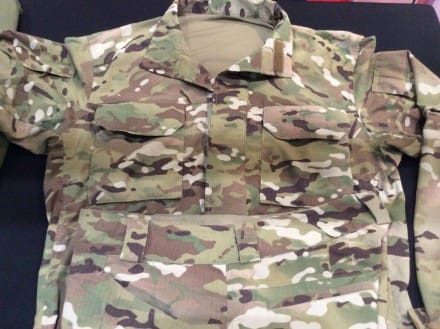
Despite assertions by those who’ve never actually seen this uniform, it’s not NYCO. The real magic here is this fabric, which feels like you took an old set of jungle fatigues and washed them over and over. It’s soft, like pajamas. Used in conjunction with a combination of mesh and a lighter liner fabric behind the pockets, they’ve got the weight of this uniform down to 1.8 lbs, a full pound lighter than a NYCO ACU. The fabric also features X-static anti-microbial treatment and a UV blocker as well as No Fly Zone bug protection and MCS Blocker to enhance breathability.
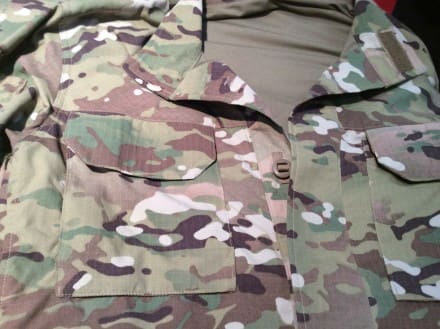
The Blouse incorporates a poly mesh yoke with a fisherman-style vent at the rear.
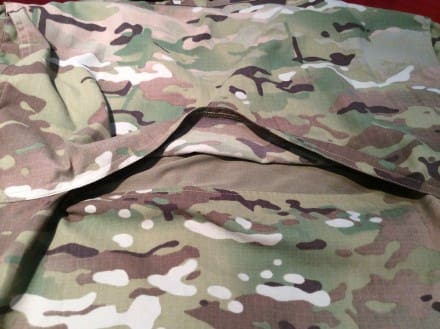
There are also waist take up tabs like on the Type -1 Jungle Fatigues.

The Pant incorporates a Tweave diamond crotch as well as Tweave capped knees.
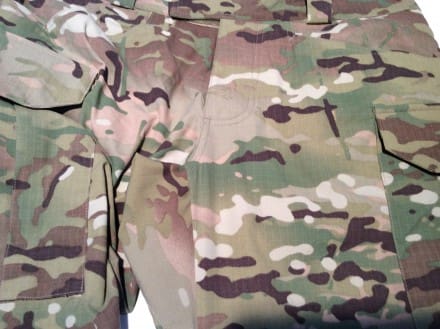
The knee pocket will accept passing, if desired.
Additionally, there is a mesh gaiter at the bottom hem that can be removed by the wearer if not needed.
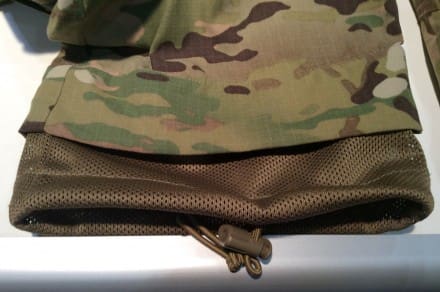
This graphic from TYR shows a good 360 view of the uniform.
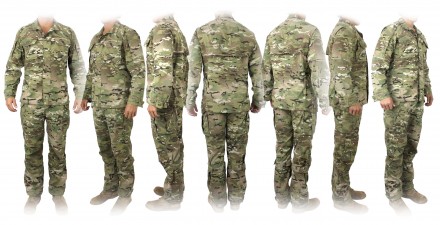
The Boonie is an update to an old classic that weighs just 3 oz. As you can see, the boonie integrates a mesh panel for cooling. It also utilizes elastic rather than standard nylon tape for the camouflage.
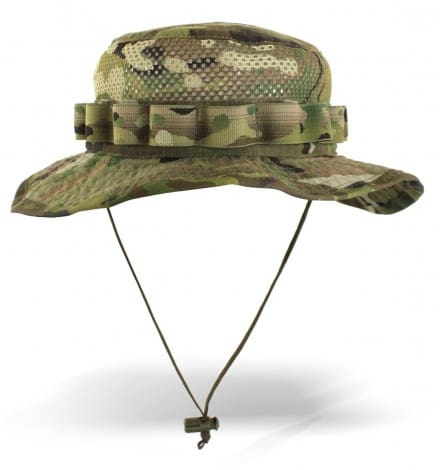
Offered in MultiCam and OD.
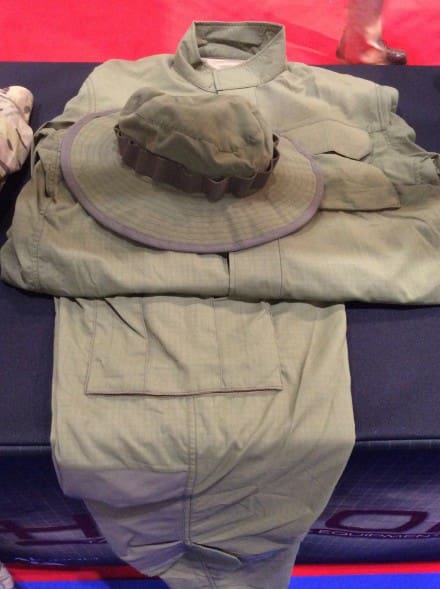
The items will be available for purchase on 1-Oct-15 but government organizations can pre-order now to take advantage of end of year funds.
TYR Tactical is unveiling their new Huron Hot Weather uniform during next week’s DSEI at London’s ExCel Center in booth N4-374.
Look for full details here on SSD.
TYR Tactical is holding a Labor Day Sale. Take advantage of 15% off closeout products. Use coupon code USAMADE to apply the discount. Sale runs from September 3rd-8th.
In case you missed last week’s post on the US Army’s Soldier Protection System – Torso and Extremity Protection program’s issues regarding contracting and requirements changes, you need the go back and read it because there were a lot of revelations by a guy who works for the company that originally developed the winning system for the USMC, before it was adopted by the Army. A commentor who adopted the monicker “Nice Try” made some interesting assertions about the government design as well as the program overall, and even went so far as to admitting to purchasing at least one commercial armor vest while working on the Scalable Modular Vest program. I’ll call that his “Edward Snowden” moment. It’s an accepted fact in the international community that governments spy on one another. Nobody makes any noise about it unless obvious evidence is presented and that’s exactly what Snowden did when he disclosed classified document after document detailing US intelligence operations. Naturally, some of those governments complained. The same goes in the tactical industry. Companies know that their competitors are buying or otherwise getting ahold of their products but no one says anything, until someone admits to doing it. “Nice Try” is that guy. His employer should expect some fallout over his actions. He also made statements that led us to believe that his company continued to work on the SMV after it was not adopted by the Marines, and picked by the Army as their SPS-TEP candidate.
One of “Nice Try’s” claims is that no commercial technologies were transferred into the SMV design but this assertion was later disputed in a comment by TYR Tactical CEO Jason Beck. In particular Beck is concerned about his patent pending ballistic vein which looks surprisingly similar to the “card” found in the MSV during industry day.
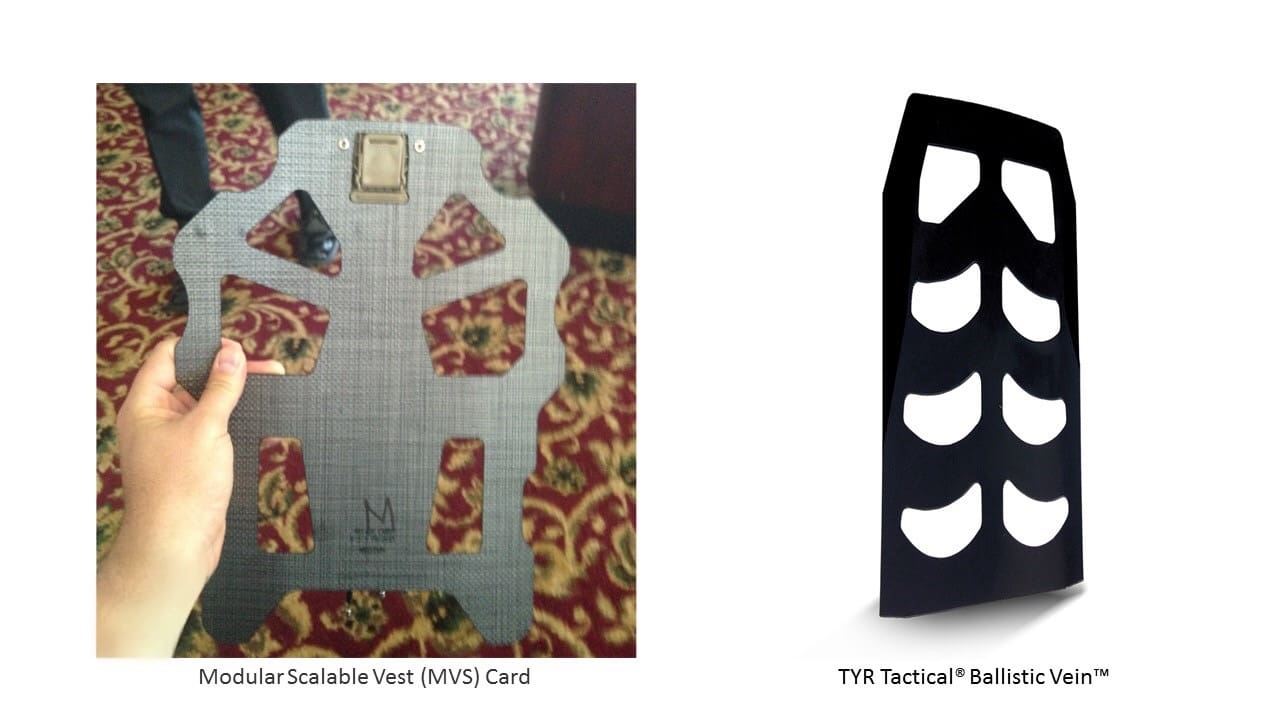
This “card” was not a component of the original MSV tested by the Marine Corps so it had to have been introduced to the vest sometime later, after it was chosen by the Army to be their SPS-TEP candidate. TYR Tactical’s patent pending ballistic vein on the other hand was a component in their vest design submitted to the program via their prime, Point Blank. I asked Jason Beck to amplify information regarding the ballistic vein in his comment on the original post and he provided this statement.
I originally designed the ballistic vein in the summer of 2010 as part of our Modular Scalable Tailorable (MST) system, which was down selected by PEO for that solicitation. There were two original intents for the advent of the vein. (Editor’s note: MST was one of the Soldier Protection Demonstrations which were designed to investigate various commercial armor technologies. For example, SPD 7 resulted in the adoption of the Soldier Plate Carrier System.)
The first intent was to increase load carriage performance specifically for a tactical nylon carrier. Historically, tactical carriers have lacked stability and rigidity. For example, if you try to set one up vertically on a table or on the floor, it will likely just fall over. Once the carrier is being worn, the same lack of structure affects the wearer’s overall load carriage when placing pouches, tools or any additional weight to the nylon. The result is pulling or sagging of the carrier, ultimately causing fatigue due to improper load carriage.
The second intent was to incorporate the vein as part of an overall system to enhance ballistic performance of both soft armor and plates. When we tested the vein in our system (and in conjunction with other manufacturers armor), it actually enhanced the overall ballistic performance of both fragmentation and stability throughout first, second and third round hits of 9mm. Back face deformation was reduced, and V50 performance was enhanced. The vein helps prevent bunching of the soft armor and supports the plates and soft armor to improve edge hit protection.
The vein has been presented multiple times to the Army in several solicitations and white papers since 2010, including the most recent SPS solicitation for which we were down selected with our former partner for SPS. Our tactical carrier and ballistic vein were submitted along with PPEs soft armor solution. The vein was an integral part of every iteration of the system that we submitted for SPS. Obviously, the TYR Tactical/PPE system was not chosen, although a ballistic vein is present in the Army’s final selection.
We have placed the vein in all of our tactical systems, and many of our other ballistic and load carriage products since it was developed in 2010. It’s original intent was solely for tactical carriers and vests, but based on the performance we have seen, it is also incorporated into multiple ballistic products ranging from low vis carriers, collars, throats, biceps, belts, etc.
What is disheartening about the vein showing up in the system that was chosen for SPS, is that we followed the process as it was presented to us, and we were assured that process would be fair and open. We went down the path to protect our IP by filing a patent, which was well documented at the beginning and throughout every step of the SPS submission process. Industry was given left and right limits to follow, but in the end those same standards were not applicable to the Army’s selection.
Ultimately, along with many other factors, led me for the first time in 17 years of business, to come to the decision to file an official protest
Based on statements by Jason Beck and “Nice Try” we know that the Army saw the technology several times and in particular during the SPS-TEP source selection process. As far as we know, it was not present in any of the other candidate’s vests during the solictation and it is not a common item found in commercial or government design armor vests, so we can say that it was thought to be unique to TYR Tactical. Yet, both have similar designs and seem to function in a similar manner. We are not sure when the Army introduced it to the government design except that it happened after the USMC accepted the original MSVs but prior to the end of the down select. Nor do we understand why and how the Army developed the card. Although TYR Tactical was a subcontractor on the SPS-TEP solicitation, they still submitted a protest due in part, to the presence of the card in the Army design, as well as other irregularities with soliciation. In responding to the protest, the Army failed to address their concerns.
TYR Tactical unveiled their award winning Jungle Ruck. The bag is made from 500D Cordura and the pack and frame together weigh in at 5.1 lbs.
Offering 2500 cu in of load carrying capacity, it incorprates PALS webbing along the back to attach additional pouches. The sides are slick to make it easier to get through brush and wait-a-minute vines. The pack also comes with accessory pouches including a mesh beavertail. You may notice a horizontal zipper about halfway down the side of the pack. In addition to being a flat pocket, it contains a hanger that can suspend optional, external pockets when needed.
The frame comes in 20 & 22 inch lengths and is made from aluminum and carbon fiber. TYR built 14 iterations of the frame, balancing weight and strength, in order to get to this version.
Make sure you check out the entire Huron pack line by downloading the 2015 catalog.
I’ve got to say unleashes because this catalog is a whopping 174 pages cover to cover, and it’s chock full of new stuff I haven’t seen before. To download your copy, click on the cover of the catalog including the new EPIC vest we previewed last week.